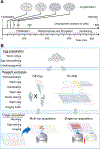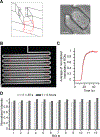High-Temporal-Resolution smFISH Method for Gene Expression Studies in Caenorhabditis elegans Embryos
- PMID: 33355449
- PMCID: PMC10619480
- DOI: 10.1021/acs.analchem.0c02966
High-Temporal-Resolution smFISH Method for Gene Expression Studies in Caenorhabditis elegans Embryos
Abstract
Recent development in fluorescence-based molecular tools has contributed significantly to developmental studies, including embryogenesis. Many of these tools rely on multiple steps of sample manipulation, so obtaining large sample sizes presents a major challenge as it can be labor-intensive and time-consuming. However, large sample sizes are required to uncover critical aspects of embryogenesis, for example, subtle phenotypic differences or gene expression dynamics. This problem is particularly relevant for single-molecule fluorescence in situ hybridization (smFISH) studies in Caenorhabditis elegans embryogenesis. Microfluidics can help address this issue by allowing a large number of samples and parallelization of experiments. However, performing efficient reagent exchange on chip for large numbers of embryos remains a bottleneck. Here, we present a microfluidic pipeline for large-scale smFISH imaging of C. elegans embryos with minimized labor. We designed embryo traps and engineered a protocol allowing for efficient chemical exchange for hundreds of C. elegans embryos simultaneously. Furthermore, the device design and small footprint optimize imaging throughput by facilitating spatial registration and enabling minimal user input. We conducted the smFISH protocol on chip and demonstrated that image quality is preserved. With one device replacing the equivalent of 10 glass slides of embryos mounted manually, our microfluidic approach greatly increases throughput. Finally, to highlight the capability of our platform to perform longitudinal studies with high temporal resolution, we conducted a temporal analysis of par-1 gene expression in early C. elegans embryos. The method demonstrated here paves the way for systematic high-temporal-resolution studies that will benefit large-scale RNAi and drug screens and in systems beyond C. elegans embryos.
Conflict of interest statement
The authors declare no conflict of interest.
Figures






Similar articles
-
Improved Methods for Single-Molecule Fluorescence In Situ Hybridization and Immunofluorescence in Caenorhabditis elegans Embryos.Curr Protoc. 2021 Nov;1(11):e299. doi: 10.1002/cpz1.299. Curr Protoc. 2021. PMID: 34826343 Free PMC article.
-
Single molecule fluorescent in situ hybridization (smFISH) of C. elegans worms and embryos.WormBook. 2012 Dec 13:1-16. doi: 10.1895/wormbook.1.153.1. WormBook. 2012. PMID: 23242966 Free PMC article. Review. No abstract available.
-
An automated microfluidic platform for C. elegans embryo arraying, phenotyping, and long-term live imaging.Sci Rep. 2015 May 7;5:10192. doi: 10.1038/srep10192. Sci Rep. 2015. PMID: 25950235 Free PMC article.
-
Large-scale sorting of C. elegans embryos reveals the dynamics of small RNA expression.Nat Methods. 2009 Oct;6(10):745-51. doi: 10.1038/nmeth.1370. Epub 2009 Sep 6. Nat Methods. 2009. PMID: 19734907 Free PMC article.
-
HT-smFISH: a cost-effective and flexible workflow for high-throughput single-molecule RNA imaging.Nat Protoc. 2023 Jan;18(1):157-187. doi: 10.1038/s41596-022-00750-2. Epub 2022 Oct 24. Nat Protoc. 2023. PMID: 36280749 Review.
Cited by
-
Microfluidics for understanding model organisms.Nat Commun. 2022 Jun 9;13(1):3195. doi: 10.1038/s41467-022-30814-6. Nat Commun. 2022. PMID: 35680898 Free PMC article. Review.
-
Comparative study of machine-and deep-learning based classification algorithms for biomedical Raman spectroscopy (RS): case study of RS based pathogenic microbe identification.Anal Sci. 2024 Dec;40(12):2101-2109. doi: 10.1007/s44211-024-00645-0. Epub 2024 Aug 29. Anal Sci. 2024. PMID: 39207655
-
Analysis of developmental gene expression using smFISH and in silico staging of C. elegans embryos.bioRxiv [Preprint]. 2024 May 16:2024.05.15.594414. doi: 10.1101/2024.05.15.594414. bioRxiv. 2024. PMID: 38798598 Free PMC article. Preprint.
-
Diversification of small RNA pathways underlies germline RNA interference incompetence in wild Caenorhabditis elegans strains.Genetics. 2024 Jan 3;226(1):iyad191. doi: 10.1093/genetics/iyad191. Genetics. 2024. PMID: 37865119 Free PMC article.
-
Single-molecule FISH in C. elegans embryos reveals early embryonic expression dynamics of par-2 , lgl-1 and chin-1 and possible differences between hyper-diverged strains.MicroPubl Biol. 2022 Jul 20;2022:10.17912/micropub.biology.000609. doi: 10.17912/micropub.biology.000609. eCollection 2022. MicroPubl Biol. 2022. PMID: 35903776 Free PMC article.
References
-
- Wood WB The Nematode Caenorhabditis Elegans; Cold Spring Harbor Laboratory: New York, 1988.
-
- Bryson-Richardson R; Berger S; Currie P Atlas of Zebrafish Development; Academic Press: San Diego, 2012.
-
- Bate M; Martinez Arias A The Development of Drosophila melanogaster; Cold Spring Harbor Laboratory: New York, 1993.
Publication types
MeSH terms
Grants and funding
LinkOut - more resources
Full Text Sources

